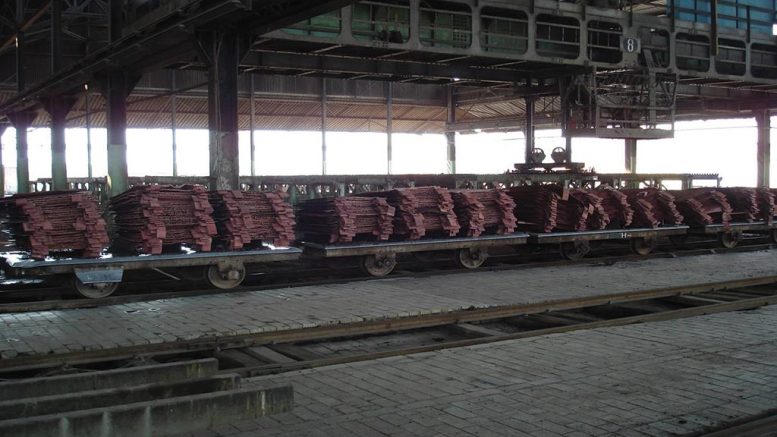Glencore (LON: GLEN) says 19 illegal artisanal miners have died, “with possible further unconfirmed fatalities,” when two galleries caved in at Kamoto Copper Co.’s KOV open-pit copper mine in the Democratic Republic of the Congo (DRC).
The mine has experienced “daily intrusions onto its concession by on average 2,000 illegal artisanal miners per day,” the Switzerland-based commodities giant said in a news release, adding that the situation “has presented a significant risk to its employees, operating equipment and the illegal artisanal miners themselves.”
Kamoto Copper Co. “has observed a growing presence of illegal artisanal miners throughout its industrial mining concessions in the Kolwezi area,” Glencore said.
The tragedy has not impacted production, the company noted.
The KOV mine is owned 75% by Kamoto Copper Co. and 25% by the DRC’s state-owned Gécamines. Katanga Mining (TSX: KAT) owns 75% of Kamoto Copper Co., and Glencore owns 85% of Katanga Mining.
Katanga’s assets in the DRC include the KOV open-pit mine and the Kamoto underground mine, Kamoto concentrator, and the Luilu metallurgical plant for the on-site production of refined copper and cobalt. Katanga describes the KOV open-pit mine as “the largest high-grade copper resource in the world.” It is made up of four orebodies — Kamoto East, Oliveira, Virgule and FNSR — and accessed by the Kamoto East and KOV pits. The Kamoto East pit operated from 1960–1985, and the adjacent KOV pit began production in 1983.
Edward Sterck, a mining analyst at BMO Capital Markets in London, said in a research note that while “exact numbers are hard to come by,” the KOV open pit “is believed to contribute around two-thirds of the ore processed at Katanga.”
Sterck also noted that Katanga Mining contributes 14% of Glencore’s net present value, and is forecast to produce 269,000 tonnes copper and 24,000 tonnes cobalt (on a 100% basis) in 2019, adding that “preventative action will likely be needed, and it could impact Glencore’s social licence to operate.”
When Glencore reported its first-quarter 2019 results in April, it noted that Katanga Mining was “managing through a period of generally excess uranium content in its cobalt material, thereby constraining exports.
“Katanga made no cobalt sales in the first-quarter 2019,” Glencore said. “From April 2019, the export of a limited quantity of cobalt, complying with appropriate regulations, was allowed to resume. Such resumption of exports remains subject to the relevant DRC export procedures, which include continued monitoring by the relevant authorities.”
Of Glencore’s 9,900 tonnes of cobalt production in the first quarter, Katanga contributed 3,500 tonnes.
In December 2018, the Ontario Securities Commission (OSC) fined Katanga along with former members of its board of directors, including Aristotelis Mistakidis, Glencore’s then head of copper trading, for disclosure violations and internal control failures that led to the company making misleading financial disclosures to investors.
In a settlement with the OSC, Katanga Mining admitted that between January 2012 and January 2017, it had failed to internally control financial reporting, as well as disclosure and procedures.
Former members of its board of directors — Mistakidis, Tim Henderson and Liam Gallagher, along with former chief financial officers Jacques Lubbe and Matthew Colwill, former director and CEO Jeffrey Best, and then director and CEO Johnny Blizzard — admitted they engaged in conduct that undermined Katanga’s corporate governance and internal controls, and a culture of compliance that resulted in Katanga overstating US$41.8 million copper-cathode production in the DRC. The individuals also said their actions resulted in improperly capitalizing impaired ore and overstating concentrate inventories totalling US$122 million.
“Gallagher, Henderson and Mistakidis served as Glencore’s nominee directors on Katanga’s board of directors and exercised significant influence over operational and financial decisions at Katanga,” OSC says in its Dec. 18, 2018 news release. “Together with Katanga’s officers, they admit to conduct that undermined Katanga’s internal controls, resulting in Katanga failing to comply with Ontario securities laws.”
Katanga agreed (separately from its directors and officers) that it failed to disclose material risks to its business, the OSC said, specifically the elevated risk of public sector corruption in the DRC and the nature and extent of Katanga’s reliance on individuals and entities associated with Dan Gertler. “Gertler’s close relationship with Joseph Kabila, the president of the DRC, and allegations of Gertler’s possible involvement in corrupt activities in the DRC, were referred to in media and non-governmental reports,” the OSC says.
As part of its settlement, Katanga Mining agreed to make a voluntary payment of $28.5 million to advance the OSC’s mandate of protecting investors, and agreed to pay $1.5 million towards OSC’s investigation.
At the time, Glencore said in a press release that it was “disappointed by the conduct that led to the settlement,” and that it had “taken appropriate remedial actions in response to this conduct.”


Be the first to comment on "Glencore confirms 19 artisanal miners dead in DRC"